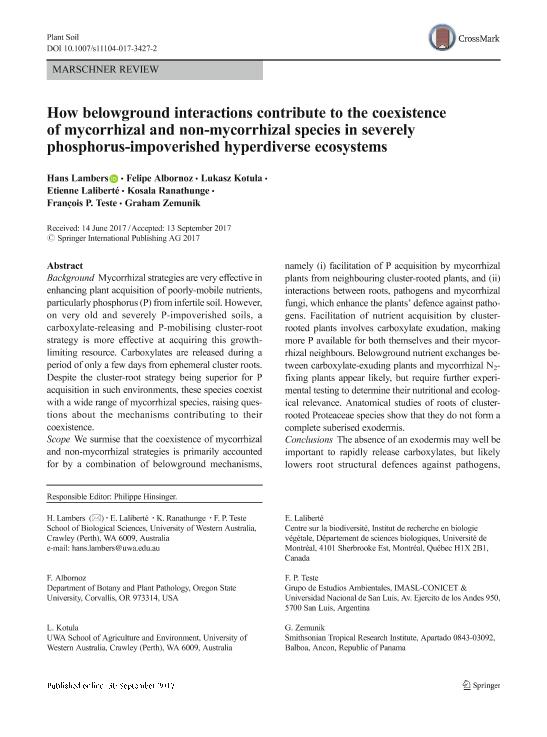Mostrar el registro sencillo del ítem
dc.contributor.author
Lambers, Hans
dc.contributor.author
Albornoz, Felipe
dc.contributor.author
Kotula, Lukasz
dc.contributor.author
Léveillé Bourret, Étienne

dc.contributor.author
Ranathunge, Kosala
dc.contributor.author
Teste, Francois

dc.contributor.author
Zemunik, Graham
dc.date.available
2018-11-26T17:33:56Z
dc.date.issued
2018-03
dc.identifier.citation
Lambers, Hans; Albornoz, Felipe; Kotula, Lukasz; Léveillé Bourret, Étienne; Ranathunge, Kosala; et al.; How belowground interactions contribute to the coexistence of mycorrhizal and non-mycorrhizal species in severely phosphorus-impoverished hyperdiverse ecosystems; Springer; Plant and Soil; 424; 1-2; 3-2018; 11-33
dc.identifier.issn
0032-079X
dc.identifier.uri
http://hdl.handle.net/11336/65182
dc.description.abstract
Background: Mycorrhizal strategies are very effective in enhancing plant acquisition of poorly-mobile nutrients, particularly phosphorus (P) from infertile soil. However, on very old and severely P-impoverished soils, a carboxylate-releasing and P-mobilising cluster-root strategy is more effective at acquiring this growth-limiting resource. Carboxylates are released during a period of only a few days from ephemeral cluster roots. Despite the cluster-root strategy being superior for P acquisition in such environments, these species coexist with a wide range of mycorrhizal species, raising questions about the mechanisms contributing to their coexistence. Scope: We surmise that the coexistence of mycorrhizal and non-mycorrhizal strategies is primarily accounted for by a combination of belowground mechanisms, namely (i) facilitation of P acquisition by mycorrhizal plants from neighbouring cluster-rooted plants, and (ii) interactions between roots, pathogens and mycorrhizal fungi, which enhance the plants’ defence against pathogens. Facilitation of nutrient acquisition by cluster-rooted plants involves carboxylate exudation, making more P available for both themselves and their mycorrhizal neighbours. Belowground nutrient exchanges between carboxylate-exuding plants and mycorrhizal N2-fixing plants appear likely, but require further experimental testing to determine their nutritional and ecological relevance. Anatomical studies of roots of cluster-rooted Proteaceae species show that they do not form a complete suberised exodermis. Conclusions: The absence of an exodermis may well be important to rapidly release carboxylates, but likely lowers root structural defences against pathogens, particularly oomycetes. Conversely, roots of mycorrhizal plants may not be as effective at acquiring P when P availability is very low, but they are better defended against pathogens, and this superior defence likely involves mycorrhizal fungi. Taken together, we are beginning to understand how an exceptionally large number of plant species and P-acquisition strategies coexist on the most severely P-impoverished soils.
dc.format
application/pdf
dc.language.iso
eng
dc.publisher
Springer

dc.rights
info:eu-repo/semantics/openAccess
dc.rights.uri
https://creativecommons.org/licenses/by-nc-sa/2.5/ar/
dc.subject
Carboxylates, Cluster Roots
dc.subject
Competition
dc.subject
Facilitation
dc.subject
Hyperdiverse Ecosystems
dc.subject
Mycorrhizas
dc.subject
Non-Mycorrhizal Plants
dc.subject
Pathogen Defence
dc.subject
Phosphorus
dc.subject
Proteaceae
dc.subject.classification
Otras Ciencias Biológicas

dc.subject.classification
Ciencias Biológicas

dc.subject.classification
CIENCIAS NATURALES Y EXACTAS

dc.title
How belowground interactions contribute to the coexistence of mycorrhizal and non-mycorrhizal species in severely phosphorus-impoverished hyperdiverse ecosystems
dc.type
info:eu-repo/semantics/article
dc.type
info:ar-repo/semantics/artículo
dc.type
info:eu-repo/semantics/publishedVersion
dc.date.updated
2018-10-23T17:41:43Z
dc.identifier.eissn
1573-5036
dc.journal.volume
424
dc.journal.number
1-2
dc.journal.pagination
11-33
dc.journal.pais
Países Bajos

dc.journal.ciudad
The Hague
dc.description.fil
Fil: Lambers, Hans. University of Western Australia; Australia
dc.description.fil
Fil: Albornoz, Felipe. State University of Oregon; Estados Unidos
dc.description.fil
Fil: Kotula, Lukasz. University of Western Australia; Australia
dc.description.fil
Fil: Léveillé Bourret, Étienne. University of Western Australia; Australia. University of Montreal; Canadá
dc.description.fil
Fil: Ranathunge, Kosala. University of Western Australia; Australia
dc.description.fil
Fil: Teste, Francois. University of Western Australia; Australia. Consejo Nacional de Investigaciones Científicas y Técnicas. Centro Científico Tecnológico Conicet - San Luis. Instituto de Matemática Aplicada de San Luis ; Argentina
dc.description.fil
Fil: Zemunik, Graham. Smithsonian Tropical Research Institute; Panamá
dc.journal.title
Plant and Soil

dc.relation.alternativeid
info:eu-repo/semantics/altIdentifier/doi/https://dx.doi.org/10.1007/s11104-017-3427-2
dc.relation.alternativeid
info:eu-repo/semantics/altIdentifier/url/https://link.springer.com/article/10.1007/s11104-017-3427-2
Archivos asociados
